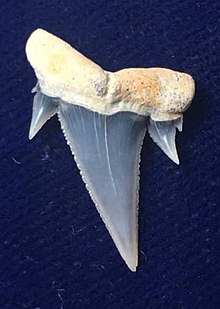| Carcharoides Temporal range: Rupelian–Langhian PreꞒ Ꞓ O S D C P T J K Pg N | |
|---|---|

| |
| Carcharoides totuserratus teeth from Argentina | |
| Scientific classification | |
| Domain: | Eukaryota |
| Kingdom: | Animalia |
| Phylum: | Chordata |
| Class: | Chondrichthyes |
| Subclass: | Elasmobranchii |
| Order: | Lamniformes |
| Family: | Lamnidae |
| Genus: | †Carcharoides Ameghino, 1901 |
| Species | |
| |
Carcharoides is an extinct genus of mackerel shark which lived during the Oligocene and Miocene epochs. It is a widespread genus, known from specimens in North and South America, Europe, Africa, and Australia. It is most common in the European portion of its range, being comparatively uncommon in other places. It is only known from isolated teeth, which are relatively delicate.
Species and affinities
There are three species, C. catticus, C. totuserratus, and C. lipsiensis. C. catticus is much more common and present from the early Oligocene until the middle Miocene. C. totuserratus is a rarer serrated species which exists in the early Miocene. C. tenuidens is a junior synonym of C. totuserratus once applied to teeth from the late oligocene of Australia. Possible transitional teeth from C. catticus to C. totuserratus are known from the late Oligocene Chandler Bridge Formation of South Carolina. C. lipsiensis was described in 2018 from the Rupelian-aged Böhlen Formation of Germany. It is unserrated.
There is debate over the placement of the position of this genus within the order Lamniformes. It has been traditionally considered a gracile member of the family Lamnidae, but some recent authors have suggested it is a robust member of the family Odontaspididae. Either way, the species is an example of convergent evolution. The lack of associated material makes confident placement difficult. Purdy (2001) synonymized this genus with Triaenodon but subsequent authors have refuted this.
References
- ^ F. Ameghino. 1901. L' age des Formations sedimentaires de Patagonie. Anales de la Sociedad Cientifica Argentina 52:189–197
- F. Chapman and F. A. Cudmore. 1924. New or little-known fossils in the National Museum, Part XXVII.-Some Cainozoic fish remains, with a revision of the group. Royal Society of Victoria 36(2):107–162
- "PBDB Taxon".
- ^ Godfrey, Stephen J., ed. (25 September 2018). "The Geology and Vertebrate Paleontology of Calvert Cliffs, Maryland, USA". Smithsonian Contributions to Paleobiology (100): 2–274. doi:10.5479/si.1943-6688.100. ISSN 1943-6688.
- ^ "elasmo.com". www.elasmo.com. Retrieved 23 August 2020.
- "REINECKE, T. & VON DER HOCHT, F. & GILLE, D. & KINDLIMANN, R. (2018) | Literature | Shark-References". www.shark-references.com. Retrieved 12 November 2020.
| Taxon identifiers | |
|---|---|
| Carcharoides | |
This article about a prehistoric shark is a stub. You can help Misplaced Pages by expanding it. |